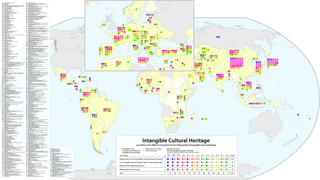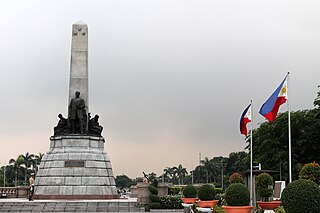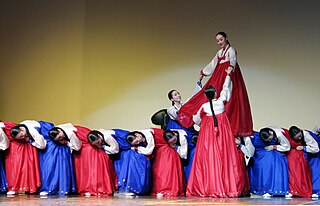Related Research Articles
The Proclamation of Masterpieces of the Oral and Intangible Heritage of Humanity was made by the Director-General of UNESCO starting in 2001 to raise awareness of intangible cultural heritage and encourage local communities to protect them and the local people who sustain these forms of cultural expressions. Several manifestations of intangible heritage around the world were awarded the title of Masterpieces to recognize the value of the non-material component of culture, as well as entail the commitment of states to promote and safeguard the Masterpieces. Further proclamations occurred biennially. In 2008, the 90 previously proclaimed Masterpieces were incorporated into the new Representative List of the Intangible Cultural Heritage of Humanity as its first entries.
An intangible cultural heritage (ICH) is a practice, representation, expression, knowledge, or skill considered by UNESCO to be part of a place's cultural heritage. Buildings, historic places, monuments, and artifacts are cultural property. Intangible heritage consists of nonphysical intellectual wealth, such as folklore, customs, beliefs, traditions, knowledge, and language. Intangible cultural heritage is considered by member states of UNESCO in relation to the tangible World Heritage focusing on intangible aspects of culture. In 2001, UNESCO made a survey among States and NGOs to try to agree on a definition, and the Convention for the Safeguarding of the Intangible Cultural Heritage was drafted in 2003 for its protection and promotion.
Living National Treasure is a Japanese popular term for those individuals certified as Preservers of Important Intangible Cultural Properties by the Minister of Education, Culture, Sports, Science and Technology as based on Japan's Law for the Protection of Cultural Properties. The term "Living National Treasure" is not formally mentioned in the law, but is an informal term referencing the cultural properties designated as the National Treasures.

The Intangible Cultural Heritage are aspects of intangible culture that the government of South Korea has officially designated for preservation in accordance with the 1962 Cultural Property Protection Law. They are proclaimed and maintained by South Korea's Cultural Heritage Administration.

UNESCO established its Lists of Intangible Cultural Heritage with the aim of ensuring better protection of important intangible cultural heritages worldwide and the awareness of their significance. This list is published by the Intergovernmental Committee for the Safeguarding of Intangible Cultural Heritage, the members of which are elected by State Parties meeting in a General Assembly. Through a compendium of the different oral and intangible treasures of humankind worldwide, the programme aims to draw attention to the importance of safeguarding intangible heritage, which UNESCO has identified as an essential component and as a repository of cultural diversity and of creative expression.
An Intangible Cultural Property, as defined by the Japanese government's Law for the Protection of Cultural Properties (1950), is a part of the Cultural Properties of high historical or artistic value such as drama, music, and craft techniques. The term refers exclusively to human skills possessed by individuals or groups which are indispensable to produce Cultural Properties.

The Philippine Registry of Cultural Property, abbreviated as PRECUP is a national registry of the Philippine Government used to consolidate in one record all cultural property that are deemed important to the cultural heritage, tangible and intangible, of the Philippines. On June 11, 2018, the entries in the newly updated PRECUP was at 3,921. Additionally, 1,259 out of 1,715 LGUs, or 73 percent of LGUs have established local cultural inventories (LCI).

The Convention for the Safeguarding of the Intangible Cultural Heritage is a UNESCO treaty adopted by the UNESCO General Conference on 17 October 2003.
A Living National Treasure, literally meaning human cultural asset, is a South Korean popular term for those individuals certified as Holders of Important Intangible Cultural Properties, also known as keepers, by the Ministry of Education as based on South Korea's Law for the Protection of Cultural Properties. The term "Living National Treasure" is not formally mentioned in the law, but is an informal term referencing the cultural properties designated as the National Treasures.
Song Deok-Gi ; was a Martial artist from Korea. One of the last practitioners of the ancient martial art of Taekkyon, he helped convey the art during the Japanese Occupation of Korea (1910-1945) and the Korean War (1950-1953). Based on his efforts, the South Korean government acknowledged Taekkyon as the 76th Important Intangible Cultural Properties of Korea and recognized him as a Human Cultural Asset (Ingan-munhwage). He used Hyeonam as a pen name.

The National Living Treasures Award, alternatively known as the Gawad sa Manlilikha ng Bayan, is conferred to a person or group of artists recognized by the Government of the Philippines for their contributions to the country's intangible cultural heritage. A recipient of the award, a National Living Treasure or Manlilikha ng Bayan is "a Filipino citizen or group of Filipino citizens engaged in any traditional art uniquely Filipino, whose distinctive skills have reached such a high level of technical and artistic excellence and have been passed on to and widely practiced by the present generations in their community with the same degree of technical and artistic competence."
Ichpedia is an online encyclopedia for the intangible cultural heritage in Korea and international arenas. It was created by a group of scholars and practitioners with the support of the Cultural Heritage Administration of the Republic of Korea. The ultimate goal is to enhance the significance of traditional cultures and cultural diversities.

The heritage preservation system of South Korea is a multi-level program aiming to preserve and cultivate Korean cultural heritage. The program is administered by the Cultural Heritage Administration, and the legal framework is provided by the Cultural Heritage Protection Act of 1962, last updated in 2012. The program started in 1962 and has gradually been extended and upgraded since then.
Intangible cultural heritage (ICH) includes traditions and living expressions that are passed down from generation to generation within a particular community.

Lahıc copper craft is a traditional folk art of Lahıc, Ismailli in Azerbaijan. It includes the production of copper crockery and other products. It was added to UNESCO's Representative List of the Intangible Cultural Heritage of Humanity in 2015.
Hudhud ni Aliguyon is a famous epic that came from the Ifugao province of Luzon in the Philippines. It narrates events about the culture and traditions of the Ifugao people and their hero, Aliguyon. Belonging in the genre of Hudhud di Ani for harvesting in the fields, this heroic epic has three functions.

The Schools of Living Traditions (SLTs) are education institutions in the Philippines dedicated to indigenous arts, crafts and other traditions.
References
- ↑ "Encouraging transmission of ICH : Living Human Treasures – intangible heritage – Culture Sector". unesco.org. Retrieved 28 August 2016.
- ↑ "Definition of Intangible Heritage", UNESCO
- ↑ Abe, Patricia (May 30, 1999). "Treasures of Japan – Its Living Artists". San Francisco Chronicle . Retrieved February 5, 2011.
- ↑ "Former furrier to the Romanian royalty named 'living human treasure' by UNESCO". romania-insider.com. 30 November 2012. Retrieved 28 August 2016.
- 1 2 "Guidelines for the Establishment of National 'Living Human Treasures' Systems", UNESCO, undated
- ↑ "Folk Tradition Bearers".
- ↑ "Nomination of 17 Masters of Living Human Treasures - United Nations Educational, Scientific and Cultural Organization". unesco.org. Retrieved 27 September 2016.